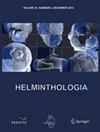Molecular characterization of Bertiella studeri infecting a primate in South India
IF 1.2
4区 生物学
Q4 PARASITOLOGY
引用次数: 0
Abstract
Summary南印度一种灵长类动物感染的 Bertiella studeri 的分子特征
摘要 Bertiella spp.是一种螨媒绦虫寄生虫,栖息于包括非人灵长类动物在内的多种哺乳动物的小肠中。本研究对从喀拉拉邦(南印度)瓦尼亚德的倭帽猕猴(Macaca radiata)小肠中发现的 Bertiella studeri 进行了形态学和分子分析。醋矾胭脂红染色鉴定了该绦虫的形态特征,如较宽的前鞭毛,其中包含不规则交替的生殖孔,单套生殖器官,280 个睾丸和一个管状横向子宫。利用 18SrRNA、ITS1-5.8S 和 COX1 基因进行了分子鉴定。使用 MEGA X 基于最大似然法(ML)(长谷川-岸野(HKY)模型)构建了系统发生树。细胞色素氧化酶 I 基因可以检测到寄生虫在两种不同宿主(即猴子(喀拉拉邦、阿根廷和肯尼亚)和人类(斯里兰卡))中存在的遗传变异。基于 COX1 的单倍型分析表明,寄生虫的单倍型在每个国家都不同,其中斯里兰卡的群体频率最高。
本文章由计算机程序翻译,如有差异,请以英文原文为准。
求助全文
约1分钟内获得全文
求助全文
来源期刊

Helminthologia
生物-动物学
CiteScore
1.80
自引率
0.00%
发文量
21
审稿时长
>12 weeks
期刊介绍:
Helminthologia (HELMIN), published continuously since 1959, is the only journal in Europe that encompasses the individual and collaborative efforts of scientists working on a different topics of human, veterinary and plant helminthology. The journal responsibility is to enrich the theoretical and practical knowledge in very specific areas and thus contribute to the advancements in human and veterinary medicine and agronomy. Taking the advantage of comprehensive and multidisciplinary approaches journal still maintains its original spirit and is principal source of fresh scientific information regarding helminths, endoparasites and plant parasites. Addressing the most up-to date topics journal gained rightful and exceptional place next to the other high-quality scientific journals publishing in its field.
 求助内容:
求助内容: 应助结果提醒方式:
应助结果提醒方式:


